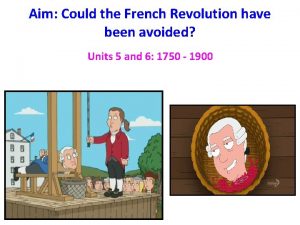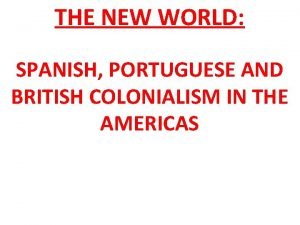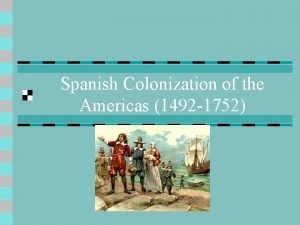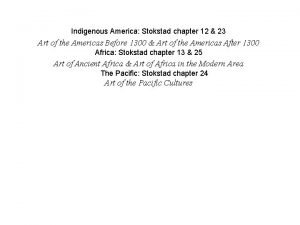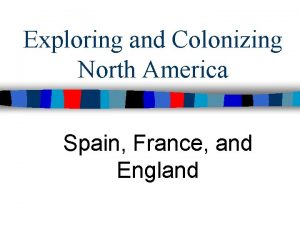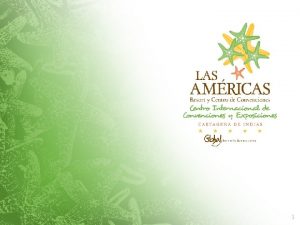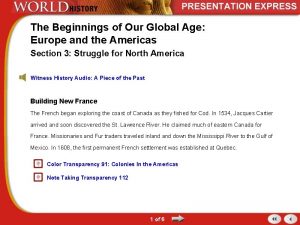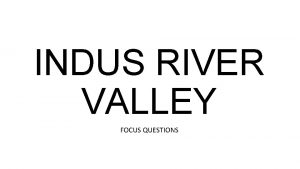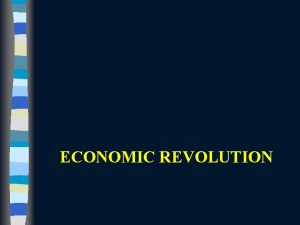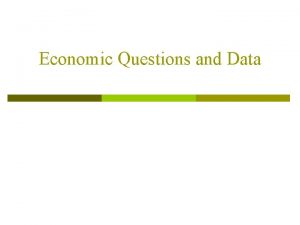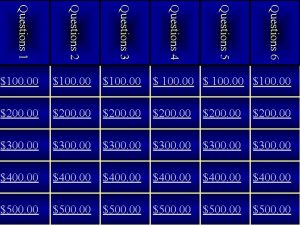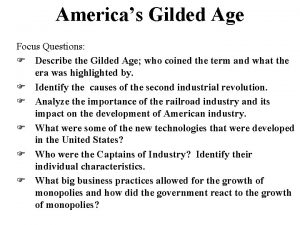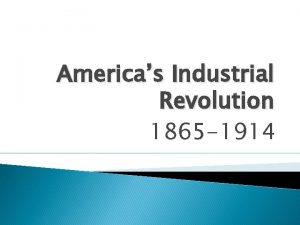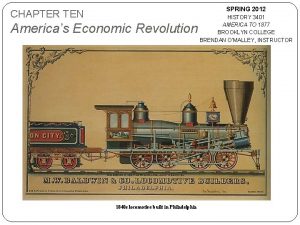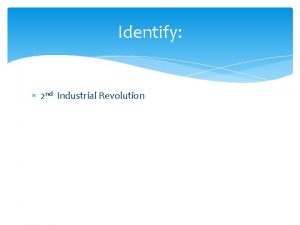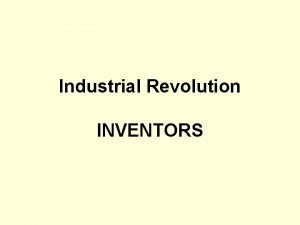Ch 10 Americas Economic Revolution Focus Questions Identify























- Slides: 23

Ch. 10: America’s Economic Revolution Focus Questions: Identify some of the major cities that developed in the United States during the market revolution. Identify some of the new immigrants who came to the United States and their characteristics. Explain the push/pull factors of this new immigration. Describe nativism and its impact on immigration. Discuss major changes in transportation and communication during the era. Explain changes in industry and business (i. e. inventors and inventions as well as the government’s role in business growth). Identify the role of class, family and women during the era. Explain the characteristics of Northern and western agriculture.

The Changing American Population The American Population, 1820 -1840 *1820: 10 m – 1840: 17 m *increasing rapidly -faster rate than Europe -mainly from better public health -higher birth rate -large amounts of immigrants *migrating towards cities in Northeast *migrating to the Northwest

Cities by 1860 Immigration and Urban Growth *New York, 1. 2 m *Philadelphia, 565, 000 *Boston, 177, 000 *River cities: St. Louis, Pittsburg, Cincinnati, New Orleans *Great Lakes cities: Buffalo, Detroit, Milwaukee, Cleveland CHICAGO *most of population in cities were made up of immigrants Immigration *1. 5 m from 1820 -1840 *mostly settled in cities *only 500, 000 in south by 1860 *most came from Europe -England, France, Italy, Scandinavia, Poland, Holland

Immigration ●Push/Pull factors

The Irish *45% of immigrants were Irish *tended to be poor and uneducated *tended to live in eastern cities *unskilled laborers or domestic workers *mostly single male or female *clannish *Catholic Push factors *economic problems *English oppression *widespread poverty *potato famine



Irish American influence in Popular Culture

Germans *27% of immigrant population *more educated and less poor *2/3 rd Protestant and 1/3 rd Catholic *mostly family units or single men *settled in Northwest *became farmers *tended to isolate themselves Push factors *economic uncertainty *political oppression -unification wars -failed liberalism (Marxism) The Germans

Notable Germans

Nativism The Rise of Nativism *distrust of foreigners *favored “Native-born” Americans Nativist fears *immigrants would work for lower wages *immigrants were destroying American culture *Catholic church and Pope *poverty *immigrants voting In Politics *Native America Party *Supreme Order of the Star-Spangled Banner *Know-Nothing Party *American Party *all wanted to restrict immigration -immigration laws -Chinese Exclusion Act *prevent immigrants from voting -literacy tests -land requirements

Transportation, Communications, and Technology The Canal Age *Erie Canal: 360 miles *connected Chicago and New York *built by Irish *huge success financially *led to increased settlement and growth of cities Steamboats *brought quicker two way traffic to rivers Railroads *best form of transportation *Why? *Baltimore and Ohio – 1830 Problems *no organization *different gauges of tracks *erratic schedules *frequent accidents *competition with canals

Increased development The Triumph of the Rails *”Trunk Lines” *shorter lines consolidated into longer lines *decreased importance of canals Funding *private companies *foreign investment *State, local and Federal governments -promoted railroad growth -provided capital -gave land grants *most railroads built in Northeast

Innovations in Communications and Journalism Telegraphs *Samuel Morse, Morse Code 1844 *solved problem of long distance communication *by 1860 – 50, 000 miles of line connecting nation *Pacific Telegraph: connected NY and San Francisco The Associated Press *cooperative news gathering by wire *large NY newspapers: Herald, Times, Tribune *sold more papers than entire south combined

Corporations Commerce and Industry *became easier to create large businesses *restrictions were lifted *simple fee was the only requirement *investment for most businesses was inadequate *limited liability -stockholders only lost value of stock if business failed Factory boom *2/3 rd factories were in Northeast *most were textile and shoe manufacturers *relied mostly on water power *many factories shut down in the winter *began to rely on steam power *coal allowed cities to not rely on water power *cities producing coal became important (Pittsburg) Technological Advances *Interchangeable parts – Eli Whitney -made clocks, guns, bikes, sewing machines, type writers *Charles Goodyear – rubber *Elias Howe/Isaac Singer – sewing machine

Early workers Women at work *two main types of workers -farmers who were replaced by machines -young, single women The Lowell System *New England factories used women mainly *lived near factories in dormitories *well fed and supervised *strict rules and curfews *generous wages for the time *paradise compared to working conditions elsewhere Problems *women suffered loneliness *repetitive tasks *work from sunrise to sunset Decline of the Lowell System *mainly from the panic of 1837 *women began to find work as teachers or servants *replaced by immigrant workers

Harsh Working Conditions Immigrant Workforce *construction gangs -build canals, railroads in horrible conditions -barely made enough money to support families *Irish workers treated like garbage *low wages *women and children paid even less *were seen as expendable *factories were loud and dangerous *12 hour workdays Early Unions *advantages to joining forces *factory owners viewed unions as illegal *Commonwealth v. Hunt -Mass. SC ruled unions were legal -other states agreed “Free Labor” *Northern laborers hated slavery -took away freedom -took away jobs

Rich and Poor Patterns of Industrial Society *economic growth not shared equally -rich got richer -poor got poorer *high poverty rates in urban areas Rich *small percentage owned majority of wealth in America *founded clubs and social rituals *advertised their opulence Central Park *NY’s attempt to compete with London/Paris *Frederick Law Olmsted *840 acres in middle of city with , lakes, hill, forests, bridges Poor *cities full of homeless *many turned to alcoholism Free Blacks *most free blacks in North lived a poor life *could not: find jobs, vote, use public services (schools)

Movement Social Mobility *laborers moved often *from one factory to another The Turner Thesis *Historian Frederick Jackson Turner *the west was a “safety valve” -during hard times people moved west -west offered new opportunities Middle Class *began to grow as a result of growing industry *easier to own a business and invest *more opportunity to own land Family changes *sons and daughters much more likely to leave home *large farms replacing small, family farms *more hired farmhands than family run farms *birth rate declines *people more concerned with working

Different roles Women and the “Cult of Domesticity” *men and women had increasingly different roles *women had no legal or political rights *husbands had absolute authority *women barred from higher education *were to become mothers -raise children and instill values *not many occupational choices -teachers, nurses and domestic servants Separate spheres *social networks for women important -clubs, associations

Working and Middle Class Leisure Activities *Sunday the only day off *holidays important *leisure time usually meant playing games, reading *vaudeville shows, plays, theatre, lectures P. T. Barnum *traveling circus was very popular -freak show, magicians, exotic animals

Northeastern Agriculture The Agricultural North *declined due to competition with west *focused more on industry *many Northeast farmers moved west *some got involved in dairy farming The Old Northwest (Ohio) *mix of industry and agriculture *Cleveland – industrial center *more specialized agriculture -Cincinnati - meatpacking industry (Porkopolis) *used river systems to sell and trade goods The Northwest (Michigan, Indiana, Illinois, Iowa, Minnesota, Missouri) *wheat, potatoes, oats, livestock *Cyrus Mc. Cormick’s reaper -greatly increased wheat production John Deere’s steel plow -opened up farming in west Rural life *churches important – brought communities together

Ch. 10: America’s Economic Revolution Focus Questions: Identify some of the major cities that developed in the United States during the market revolution. Identify some of the new immigrants who came to the United States and their characteristics. Explain the push/pull factors of this new immigration. Describe nativism and its impact on immigration. Discuss major changes in transportation and communication during the era. Explain changes in industry and business (i. e. inventors and inventions as well as the government’s role in business growth). Identify the role of class, family and women during the era. Explain the characteristics of Northern and western agriculture.
 Language
Language Porter competitive strategy
Porter competitive strategy Two fundamental business strategies are
Two fundamental business strategies are Actor focus vs object focus
Actor focus vs object focus Russian revolution vs french revolution
Russian revolution vs french revolution Did american revolution cause french revolution
Did american revolution cause french revolution Third agricultural revolution
Third agricultural revolution Economic causes of the french revolution
Economic causes of the french revolution Economic causes of french revolution
Economic causes of french revolution You should hope that this game will be over soon
You should hope that this game will be over soon Economic growth vs economic development
Economic growth vs economic development Prof. meier and baldwin
Prof. meier and baldwin Economics unit 1 lesson 2 difficult choices
Economics unit 1 lesson 2 difficult choices Spanish caste system in the americas
Spanish caste system in the americas Spanish colonization of the americas
Spanish colonization of the americas Soroptimist international of the americas
Soroptimist international of the americas Art of the americas before 1300
Art of the americas before 1300 Ib questions
Ib questions Who colonized north america
Who colonized north america Declaración sobre seguridad en las américas 2003
Declaración sobre seguridad en las américas 2003 Spanish caste system
Spanish caste system Americas guardians mc
Americas guardians mc Centro internacional de convenciones
Centro internacional de convenciones The beginnings of our global age europe and the americas
The beginnings of our global age europe and the americas









